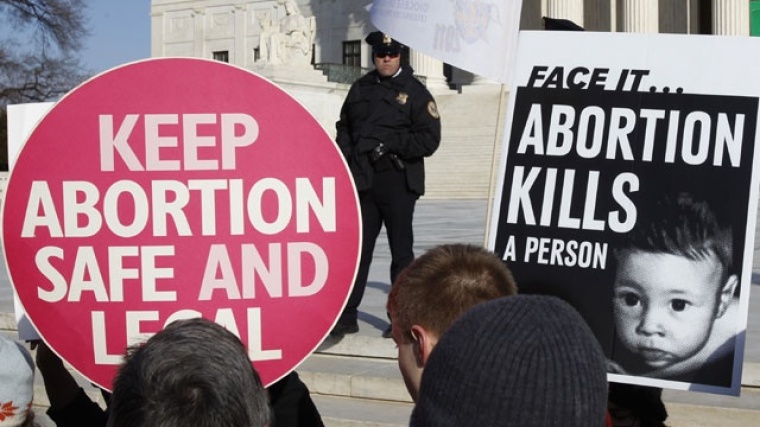One in four pregnancies end in abortion, says study; Christian pregnancy advice group says information could lessen abortion cases
Research reveals that one in every four pregancies end up being terminated. With this, a Christian center focused on providing sex education and advice regarding pregnancy said that disseminating more information could lessen the chances of girls and women seeking to have abortions.
"We do sex and relationships education in schools and that's the sort of thing that's getting squeezed out of the school curriculum," Karen Pitchford, director at Crossway Pregnancy Advice Centre, told Premier, "and I think it's very important that all over the world women and men have access to information to make good choices."

The May 2016 fact sheet released by the Guttmacher Institute says that 25 percent of pregnancies from 2010 to 2014 ended in abortion. There was an estimated 56.3 million induced abortions annually during that period, which represents a significant increase from the estimated annual 50.4 million between 1990 and 1994.
"I think these statistics are tragic, and it really points to the fact that abortion increasingly is seen as a solution to unplanned pregnancies and problematic pregnancies, and that is highly disturbing," James Mildred of Christian charity CARE told Premier. "There are other options out there other than just having an abortion."
According to the study, developing countries have an abortion rate of 37 per 1,000 in 2010-2014. The number used to be 38.6 million but increased to 49.6 million. In the said period, the Caribbean topped the list of regions with the highest abortion rate, estimated to be at 65 per 1,000 women of childbearing age. South Africa lands in second place at 47.
The estimate in developed countries is 27 per 1,000, lower than the 46 per 1,000 estimate during the 1990-1994 period. Previously the number of abortions in developed countries was 11.8 milion per year but declined to 6.7 million. The region with the lowest rate of abortion of 17 per 1,000 is North America, followed by Western Europe and Northern Europe, each having 18 per 1,000.
"In developed countries, the continued fall in abortion rates is largely due to increased use of modern contraception that has given women greater control over the timing and number of children they want," said Dr Gilda Sedgh of the Guttmacher Institute. "In developing countries, however, family planning services do not seem to be keeping up with the increasing desire for smaller families. More than 80 percent of unintended pregnancies are experienced by women with an unmet need for modern methods of contraception, and many unwanted pregnancies end in abortion."
Sedgh said there are more incidents of abortion in countries that have very restrictive abortion laws partly because although many women don't want to get pregnant, their needs for contraception are unmet. This echoes what the study says that there is no association between lower abortion rates and highly restrictive abortion laws; rather, "High levels of unmet need for contraception help explain the prevalence of abortion in countries with restrictive abortion laws."
"It's not something that's happened since abortions have been legal, and banning it will not change that at all," Pitchford said. "It will just make it more of a risk to women in that situation, whereas with legal abortions at least there's very litttle risk to the woman in that situation."
 Christians don't have to affirm transgenderism, but they can’t express that view at work: tribunal
Christians don't have to affirm transgenderism, but they can’t express that view at work: tribunal Archaeology discovery: Medieval Christian prayer beads found on Holy Island
Archaeology discovery: Medieval Christian prayer beads found on Holy Island Presbyterian Church in America votes to leave National Association of Evangelicals
Presbyterian Church in America votes to leave National Association of Evangelicals Over 50 killed in 'vile and satanic' attack at Nigerian church on Pentecost Sunday
Over 50 killed in 'vile and satanic' attack at Nigerian church on Pentecost Sunday Ukrainian Orthodox Church severs ties with Moscow over Patriarch Kirill's support for Putin's war
Ukrainian Orthodox Church severs ties with Moscow over Patriarch Kirill's support for Putin's war Islamic State kills 20 Nigerian Christians as revenge for US airstrike
Islamic State kills 20 Nigerian Christians as revenge for US airstrike Man who served 33 years in prison for murder leads inmates to Christ
Man who served 33 years in prison for murder leads inmates to Christ


 Nigerian student beaten to death, body burned over ‘blasphemous’ WhatsApp message
Nigerian student beaten to death, body burned over ‘blasphemous’ WhatsApp message 'A new low': World reacts after Hong Kong arrests 90-year-old Cardinal Joseph Zen
'A new low': World reacts after Hong Kong arrests 90-year-old Cardinal Joseph Zen Iran sentences Christian man to 10 years in prison for hosting house church worship gathering
Iran sentences Christian man to 10 years in prison for hosting house church worship gathering French Guyana: Pastor shot dead, church set on fire after meeting delegation of Evangelicals
French Guyana: Pastor shot dead, church set on fire after meeting delegation of Evangelicals ‘Talking Jesus’ report finds only 6% of UK adults identify as practicing Christians
‘Talking Jesus’ report finds only 6% of UK adults identify as practicing Christians Mission Eurasia ministry center blown up in Ukraine, hundreds of Bibles destroyed: 'God will provide'
Mission Eurasia ministry center blown up in Ukraine, hundreds of Bibles destroyed: 'God will provide' Church holds service for first time after ISIS desecrated it 8 years ago
Church holds service for first time after ISIS desecrated it 8 years ago Burger King apologizes for 'offensive campaign' using Jesus' words at the Last Supper
Burger King apologizes for 'offensive campaign' using Jesus' words at the Last Supper Uganda: Muslims abduct teacher, burn him inside mosque for praying in Christ’s name
Uganda: Muslims abduct teacher, burn him inside mosque for praying in Christ’s name